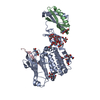| 登録情報 | データベース: PDB / ID: 8hc0
|
|---|
| タイトル | Crystal structure of the extracellular domains of GPR110 |
|---|
 要素 要素 | (Adhesion G-protein coupled receptor ...) x 3 |
|---|
 キーワード キーワード | CELL ADHESION / Adhesion GPCR / GPR110 / synaptamide / molecular dynamics simulations |
|---|
| 機能・相同性 |  機能・相同性情報 機能・相同性情報
energy reserve metabolic process / fat cell differentiation / regulation of lipid metabolic process / synapse assembly / G protein-coupled receptor activity / memory / adenylate cyclase-activating G protein-coupled receptor signaling pathway / neuron projection development / cytoplasmic vesicle / cell surface receptor signaling pathway ...energy reserve metabolic process / fat cell differentiation / regulation of lipid metabolic process / synapse assembly / G protein-coupled receptor activity / memory / adenylate cyclase-activating G protein-coupled receptor signaling pathway / neuron projection development / cytoplasmic vesicle / cell surface receptor signaling pathway / G protein-coupled receptor signaling pathway / extracellular region / membrane / plasma membrane類似検索 - 分子機能 GPCR family 2, Ig-hepta-like receptor / : / SEA domain profile. / SEA domain / SEA domain / GAIN domain superfamily / GPCR proteolysis site, GPS, motif / : / GPS motif / GAIN-B domain profile. ...GPCR family 2, Ig-hepta-like receptor / : / SEA domain profile. / SEA domain / SEA domain / GAIN domain superfamily / GPCR proteolysis site, GPS, motif / : / GPS motif / GAIN-B domain profile. / G-protein-coupled receptor proteolytic site domain / GPCR, family 2, secretin-like / 7 transmembrane receptor (Secretin family) / GPCR, family 2-like / G-protein coupled receptors family 2 profile 2.類似検索 - ドメイン・相同性 |
|---|
| 生物種 |  Homo sapiens (ヒト) Homo sapiens (ヒト) |
|---|
| 手法 |  X線回折 / X線回折 /  シンクロトロン / シンクロトロン /  分子置換 / 解像度: 2.9 Å 分子置換 / 解像度: 2.9 Å |
|---|
 データ登録者 データ登録者 | Wang, F.F. / Song, G.J. |
|---|
| 資金援助 |  中国, 1件 中国, 1件 | 組織 | 認可番号 | 国 |
|---|
| National Natural Science Foundation of China (NSFC) | 32171215 |  中国 中国 |
|
|---|
 引用 引用 |  ジャーナル: J.Mol.Biol. / 年: 2023 ジャーナル: J.Mol.Biol. / 年: 2023
タイトル: Crystal Structure of the Extracellular Domains of GPR110.
著者: Wang, F. / Wang, Y. / Qiu, W. / Zhang, Q. / Yang, H. / Song, G. |
|---|
| 履歴 | | 登録 | 2022年11月1日 | 登録サイト: PDBJ / 処理サイト: PDBC |
|---|
| 改定 1.0 | 2023年9月13日 | Provider: repository / タイプ: Initial release |
|---|
| 改定 1.1 | 2023年9月20日 | Group: Refinement description / カテゴリ: pdbx_initial_refinement_model / Item: _pdbx_initial_refinement_model.type |
|---|
| 改定 1.2 | 2024年5月1日 | Group: Database references / カテゴリ: citation
Item: _citation.page_last / _citation.pdbx_database_id_PubMed / _citation.title |
|---|
| 改定 1.3 | 2024年10月30日 | Group: Structure summary
カテゴリ: pdbx_entry_details / pdbx_modification_feature
Item: _pdbx_entry_details.has_protein_modification |
|---|
|
|---|
 データを開く
データを開く 基本情報
基本情報 要素
要素 キーワード
キーワード 機能・相同性情報
機能・相同性情報 Homo sapiens (ヒト)
Homo sapiens (ヒト) X線回折 /
X線回折 /  シンクロトロン /
シンクロトロン /  分子置換 / 解像度: 2.9 Å
分子置換 / 解像度: 2.9 Å  データ登録者
データ登録者 中国, 1件
中国, 1件  引用
引用 ジャーナル: J.Mol.Biol. / 年: 2023
ジャーナル: J.Mol.Biol. / 年: 2023 構造の表示
構造の表示 Molmil
Molmil Jmol/JSmol
Jmol/JSmol ダウンロードとリンク
ダウンロードとリンク ダウンロード
ダウンロード 8hc0.cif.gz
8hc0.cif.gz PDBx/mmCIF形式
PDBx/mmCIF形式 pdb8hc0.ent.gz
pdb8hc0.ent.gz PDB形式
PDB形式 8hc0.json.gz
8hc0.json.gz PDBx/mmJSON形式
PDBx/mmJSON形式 その他のダウンロード
その他のダウンロード 8hc0_validation.pdf.gz
8hc0_validation.pdf.gz wwPDB検証レポート
wwPDB検証レポート 8hc0_full_validation.pdf.gz
8hc0_full_validation.pdf.gz 8hc0_validation.xml.gz
8hc0_validation.xml.gz 8hc0_validation.cif.gz
8hc0_validation.cif.gz https://data.pdbj.org/pub/pdb/validation_reports/hc/8hc0
https://data.pdbj.org/pub/pdb/validation_reports/hc/8hc0 ftp://data.pdbj.org/pub/pdb/validation_reports/hc/8hc0
ftp://data.pdbj.org/pub/pdb/validation_reports/hc/8hc0 F&H 検索
F&H 検索 リンク
リンク 集合体
集合体
 要素
要素 Homo sapiens (ヒト) / 遺伝子: ADGRF1, GPR110, PGR19 / 細胞株 (発現宿主): HEK293gnt-
Homo sapiens (ヒト) / 遺伝子: ADGRF1, GPR110, PGR19 / 細胞株 (発現宿主): HEK293gnt- Homo sapiens (ヒト) / 遺伝子: ADGRF1, GPR110, PGR19 / 細胞株 (発現宿主): HEK293gnt-
Homo sapiens (ヒト) / 遺伝子: ADGRF1, GPR110, PGR19 / 細胞株 (発現宿主): HEK293gnt- Homo sapiens (ヒト) / 遺伝子: ADGRF1, GPR110, PGR19 / 細胞株 (発現宿主): HEK293gnt-
Homo sapiens (ヒト) / 遺伝子: ADGRF1, GPR110, PGR19 / 細胞株 (発現宿主): HEK293gnt-

 X線回折 / 使用した結晶の数: 1
X線回折 / 使用した結晶の数: 1  試料調製
試料調製 シンクロトロン / サイト:
シンクロトロン / サイト:  SSRF
SSRF  / ビームライン: BL10U2 / 波長: 0.9792 Å
/ ビームライン: BL10U2 / 波長: 0.9792 Å 解析
解析 分子置換
分子置換 ムービー
ムービー コントローラー
コントローラー



 PDBj
PDBj

